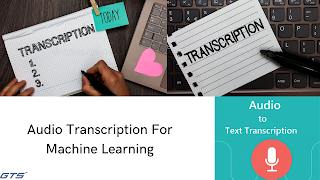How Audio Data Transciption Can Develop Machine Learning Models?
If you require assistance in any way, or would like to ask a short query, turn to Google Assistant or Siri or Alexa to ask them questions and receive a response in a matter of minutes. Assistants convert your audio into text, translate it, then search the internet for responses, and then translate the message to you using speech. While the voice-based assistants were in use from the 60s onwards they have observed their increasing use in the last few years.
To develop the AI to recognize spoken words, the transcription process is essential. For a fraction of expense and time, automated speech transcription has achieved close to human precision levels. If you're trying to increase the accuracy of automated Speech Datasets, then you'll require the assistance of human transcriptionists. This article discusses the definition of audio transcription service for AI as well as the distinction from humans or AI transcription, the various applications and much more.
What is the definition of Audio Transcription to do with AI?
When it is about the transcription of audio files, there's the distinction between general transcription and transcription that is specifically designed for AI. AI model. The use of audio transcription in AI is a method of transcription which is employed to train, test and verify voice recognition on many different applications such as voice assistants as well as bots for customer service.
The transcriptionist (whether it's a human as well as a machine) captures what is said, during the time it is spoken, as well as the person who said it. In some cases, transcription may also contain non-verbal words, or background sounds. The speech data that is transcribed for AI could be human-to-human speech (like vocal instructions or words for wake) or human to the human voice (like interviews or telephone conversations). The transcription of speech for AI differs from general speech transcription that can be used for anything from podcasts to interviews, office meetings doctor's appointments and legal proceedings, television shows and customer service calls. The transcription itself is often the final of the story in this instance.
The process of learning through machine is in its essence it is a mix of ML Dataset and a model. As ML has grown and grown, there has been a lot of emphasis placed on making adjustments and optimizing the model to achieve the most efficient performance. In keeping with this trend more attention is being observed today on the ML DataOps which is the portion of MLOps which focuses on the gathering of, processing, and utilization of data, complete with a feedback process.
Three key points of the report:
A well-structured data operations pipeline for ML allows you to manage data on a large scale while it is on the cycle that is AI learning and deployment. The critical transition from test to production has to be handled by utilizing repeatable and scalable procedures in order to ensure the long-term viability of the final AI solutions.
Inside in the ML DataOps ecosystem, companies concentrate on various elements of the process of data and provide their unique solutions to market. The solutions provided by the companies in the ecosystem generally fall into the following categories: people, technology, tools and processes, which are end-to-end services.
The final step of AI development is solving edge situations. The ability to deal with edge situations can determine the efficiency of a machine learning system that has been trained. Companies within the industry are always looking for ways to seamlessly combine human knowledge and tools to assist in monitoring, auditing and dealing with difficult situations. This is an essential step to get ML over the last obstacles to be able to run production.
What are the applications of audio in real-world situations?
There are a variety of areas and industries where audio transcription is used Some of these are:
- Medicine: Nurses and doctors are required to keep a vast quantity of documents of their interactions with parents and their treatment plans, prescriptions as well as other data. To make their work more efficient they can make use of Audio Transcription services to record this information , and get it automatically transcribing. Medical professionals rely on precise transcription to make sure that patients receive the correct treatment. For instance, if the transcription does not accurately record the number of times a patient needs to take a medication this could lead to devastating consequences for the health of the patient.
- Social media: You may have noticed on social media sites like YouTube as well as Instagram that certain videos come with captioning capabilities. This is a brand new feature that utilizes AI to automatically caption people in the moment they speak. While it isn't always going to be precise, it can contribute to improved accessibility and usability for users.
- Technology: Talk-to-text is accessible on smartphones for a long time. It lets you text people using audio dictation, instead of typing manually an email like the name implies.
- Legal: The accuracy of documenting court procedures is crucial in law , as it can impact the result of an instance. The documentation of the past is important so that future court cases can take lessons from or reference.
- Police: The police have a variety of programs for audio transcription used in the police field and more are likely to follow. It is used to translate interviews with investigators as well as evidence records and body cameras, police calls recorded interactions, as well as other things. Their accuracy, just like those required by law, could have a profound impact on court proceedings and the lives of people.

Comments
Post a Comment